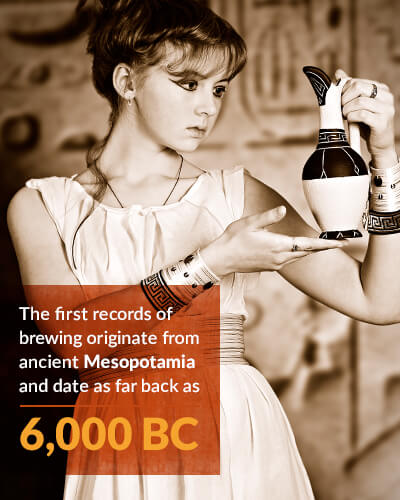Crafting Great Beer and Spirits
Whether you’re pulling up a barstool at your favorite local pub for that customary pint with friends or whetting your palate with a more sophisticated brew at a world-famous microbrewery and distillery, a cold beer or your favorite liquor on the rocks always has a place at the table.
From Ancient to Modern Processes
 Since the dawn of human civilization, the same ingredients have come together to craft the flavorful, aromatic and unique beer styles we find throughout the world today. Grain, yeast and water have been used for centuries. The first records of brewing originate from ancient Mesopotamia, and date as far back at 6,000 B.C. in what is present-day Iraq and Egypt. Over thousands of years, the process of brewing has changed with the addition of hops and advancements in technology.
Since the dawn of human civilization, the same ingredients have come together to craft the flavorful, aromatic and unique beer styles we find throughout the world today. Grain, yeast and water have been used for centuries. The first records of brewing originate from ancient Mesopotamia, and date as far back at 6,000 B.C. in what is present-day Iraq and Egypt. Over thousands of years, the process of brewing has changed with the addition of hops and advancements in technology.
When it comes to crafting spirits, especially whisky, many of the same brewing processes are used in distillation. Whisky and beer may not seem similar in their final form, but the two are essentially comprised of the same ingredients — they just happen to be used in different ways: Fermentation of the wort to create beer, and distillation to create whisky.
Even though the art of brewing and distilling is ancient, improvements and creative ideas are still being made to further perfect the recipe. Industrial brewing is an energy-intensive process that requires both thermal and electrical energy to produce the ales, lagers, stouts and porters you see bottled on store shelves and poured into the glasses at your local pub.
The same methods of heating and cooling are also required for the manufacture of whisky and other spirits. The amount of energy expended varies greatly depending on the tools used, the efficiency of the brewing or distillation equipment, how the product is packaged and the size and age of the brewery or distillery.
For boiling, thermal energy is commonly expended through coal or natural gas, and is used primarily in the early process. However, electricity is often used in cooling, refrigeration, bottling and packaging. For breweries and distilleries, one of the primary equipment resources employed in both production and bottling are compressed air systems. It’s common to use compressed air for bottling both beer and spirits.
It takes a high amount of electrical horsepower to be converted into compressed air power. According to the average estimate, it takes between 7 and 8 HP of electrical power to produce just 1 HP of compressed air power.
Microbreweries simply don’t have the same profit margins as larger breweries, and that makes energy efficiency even more vital when creating a sustainable pint for their customers.
Implementing more efficient compressed air systems on the production line and in bottling plants can drastically reduce energy expenses when crafting microbrews or distilling malts and grains.
Compressed Air’s Role in Today’s Breweries
Breweries today wouldn’t be able to produce consistent quality products without compressed air. A Quincy air compressor can be used in several aspects of the overall beer brewing process, including:
- Bottling: Bottling is a common application for air compressors in home breweries and smaller commercial operations. Pressurized air is essential for moving beer from the conditioning tank to the bottle and keeping lines clean and free of water.
- Clarifying: Several prominent microbreweries — such as Asheville, NC’s Wicked Weed Brewing — use compressed air to power machinery during clarifying. After primary fermentation, many of the brewery’s beers are clarified using a pressure-driven centrifuge that removes heavier solids and creates a cleaner, clearer finished product.
- Aeration: Aeration is required to ensure yeast cultures have sufficient oxygen during fermentation. Clean air is the best, most reliable way to do this to promote quality control. These applications typically employ an oil-free compressor to reduce contamination risk.
- Cleanup and maintenance: Air compressors power tools such as pressure washers, which are essential for maintaining a clean and sanitary operation. Many breweries also use air-powered drills, screwdrivers, hammers and other tools for regular maintenance and installation of new equipment.
For barley-based brews, the general process can involve:
- Malting: The grains are soaked for 40 hours before drying in a kiln.
- Milling: Next, the grains are cracked so they’ll absorb the water needed to extract their sugars.
- Mashing: More water is added and the milled grains soak for 1-2 hours.
- Lautering: This step separates the sweet wort from the grains.
- Boiling: Next, the wort is boiled and hops are added.
- Cooling: The wort is then cooled in a whirlpool.
- Fermentation: The cooled, hopped wort is left alone, allowing yeast to consume the sugar released earlier in the brewing process, turning it into alcohol.
- Conditioning: To settle the yeast and thicken the proteins, the beer is cooled to near freezing.
- Filtering: This step is key for flavor stabilization.
- Bottling: Finally, the beer is transferred into bottles or kegs for distribution.
To support these and other applications, Quincy Compressor manufactures a comprehensive line of products in a range of sizes and configurations. Whether you’re looking for a versatile variable-speed machine capable of running different equipment types at once, or a specialized product for one aspect of your operation, we can help.
Types of Air Compressors
The best type of air compressor for brewing beer will depend on numerous factors, including your operation’s size, your intended purpose, space considerations and, of course, your budget. Quincy Compressor is one of the world’s oldest and most diverse compressor manufacturers. Our products are found in breweries across North America and around the world.
Some of our most popular air compressors for microbreweries and home beer production include:
- QGS: This air compressor series consists of several highly efficient screw drive units that meet the demands of industrial operations. Units range from 5 to 100 horsepower and are engineered for 100% duty cycle operation.
- QGD: These gear drive compressors range from 15 to 60 horsepower and produce between 100 and 150 pounds per square inch gauge (psig). Rugged yet quiet, their beltless design minimizes maintenance requirements.
- QSI: This series of premium industrial direct air drive compressors is among our most durable and powerful product lines. It consists of machines ranging from 20 to 350 horsepower, with capacities up to 1,500 cubic feet per minute (CFM). The QSI line includes some of our best air compressors for breweries running multiple air tools simultaneously.
- QT: These two-stage reciprocating compressors pack significant power into a small footprint. They are a great choice for home and light industrial use, available in 3- to 15-horsepower configurations.
- QP: These industrial-duty compressors, which are fully pressure-lubricated for smoother continuous operation, can deliver up to 175 psig. Use them for any brewery application in which a lighter-duty machine won’t do.
- QR-25: This compressor is a recognized industry workhorse with roots dating back to the 1930s. Today’s QR-25 compressors produce more capacity per horsepower than the competition, making them a great choice for any budget-conscious brewery — they’re efficient machines that won’t compromise on performance.
Guide to Crafting Great Beer and Spirits
Throughout this guide, you will learn about beer’s origins, the general process of brewing and distilling and some important methods for improving energy efficiency at breweries, distilleries and bottling plants.
Energy savings for breweries can be easy to achieve with strategies that cost little — or are even free. Boilers, refrigeration systems, compressed air systems and packaging systems all vary in how much energy they utilize, but by turning equipment off when it’s not in use, optimizing the system for its proper application and conducting routine maintenance, brewers and distillers can significantly improve their savings.
By employing simple steps in both maintenance and plant practices, microbreweries and small distilleries can reduce their annual expenses while still maintaining standards high enough to deliver the best drink possible to their customers.
Last Updated on August 28, 2023 at 1:30 PM
Table of Contents
- Crafting Great Beer and Spirits
- Chapter 1: A Brief History of Beer — An Ancient Beverage
- Chapter 2: Nature's Contribution — The Ingredients
- Chapter 3: The Art of Brewing and Distillation
- Chapter 4: The Tools of the Trade — Vessels, Stills, and Compressors
- Chapter 5: How to Increase Energy Efficiency in Microbreweries and Distilleries
- Chapter 6: How to Save Money in Production Line with Better Bottling Practices
- Chapter 7: The Microbrewing and Craft Beer Movement
- Chapter 8: Evolution of Crafting Beer and Whiskey

